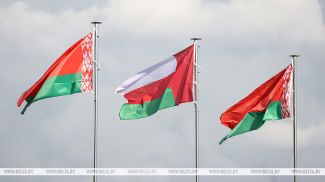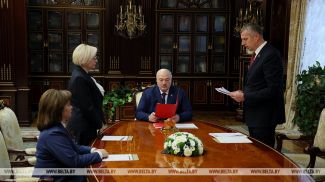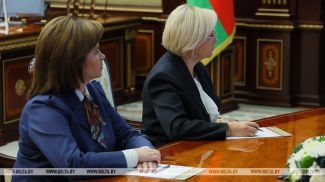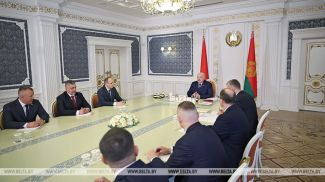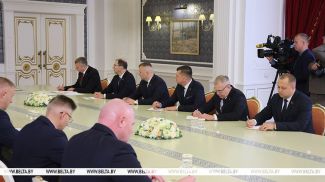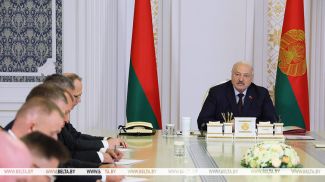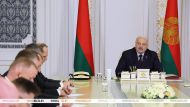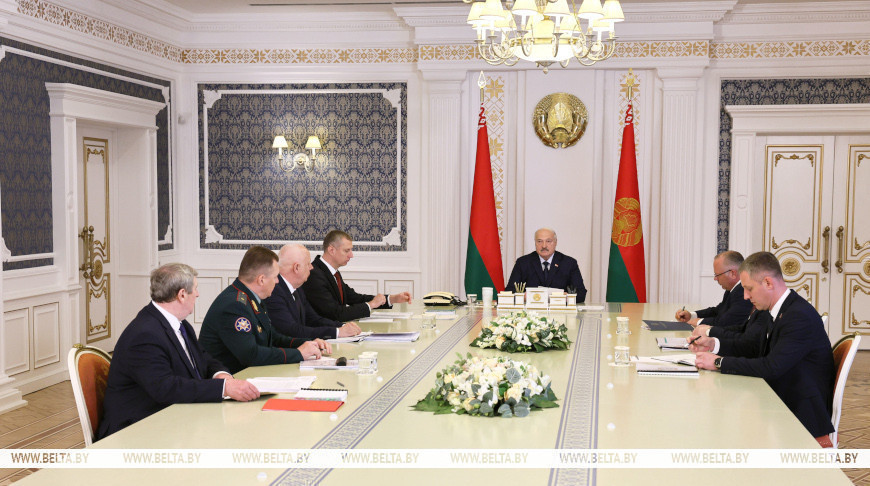
MINSK, 25 April (BelTA) – I intend to comprehensively analyze the results of the programs to revive the territories affected by the Chernobyl disaster, Belarusian President Aleksandr Lukashenko said as he received a report on the development of the districts of Gomel Oblast affected by the Chernobyl accident on 25 April, BelTA has learned.
Participating in the meeting were Head of the Belarus President Administration Dmitry Krutoi, Chairman of the State Control Committee of Belarus Vasily Gerasimov, Deputy Prime Minister Anatoly Sivak, Chairman of the Gomel Obalst Executive Committee Ivan Krupko, Emergencies Minister Vadim Sinyavsky, Aide to the President, Inspector for Gomel Oblast Ruslan Parkhamovich, and Chairman of the Standing Commission on Legislation and State Building of the Council of the Republic of the National Assembly of Belarus Mikhail Rusy.
The meeting focused on the support measures, environmental programs, and social and economic initiatives for residents of Gomel Oblast affected by the Chernobyl disaster.
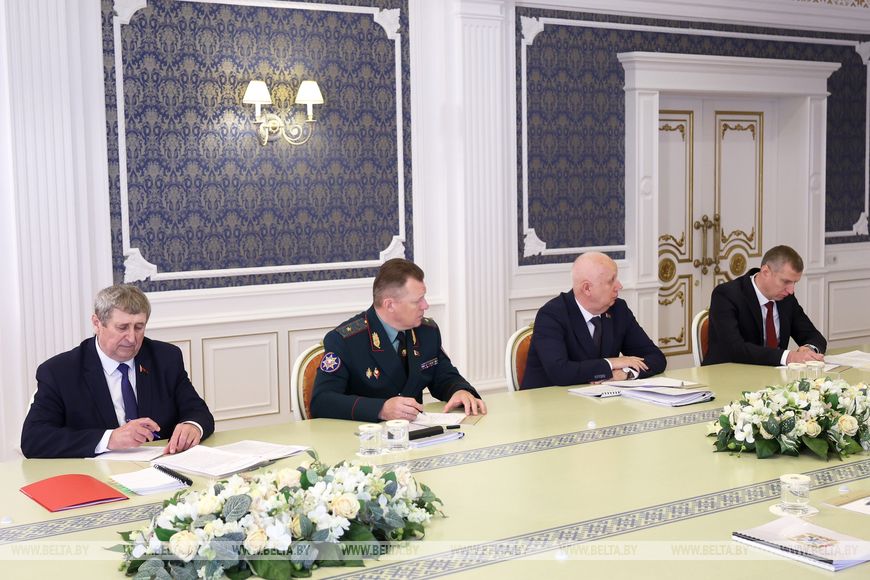
The president recalled that 2026 will mark 40 years since the Chernobyl nuclear power plant accident. This is a significant date for Belarus. Although the country had no involvement either the construction of the nuclear power plant, its operation or the reasons that led to its explosion, yet it suffered the worst. "The tragedy hit Belarus and its people harder than anyone else," Aleksandr Lukashenko emphasized.
The head of state recalled that the first ten years since the accident were a time of uncertainty and fear-mongering. “I remember it well. When I was still MP, I traveled to these districts to learn what was happening there. Ten years of confusion. Some people were evicted, resettled. Something was built; something was done. Then we came back to our senses and realized that there was no other land or other country for Belarusians. We realized that we had to think how to live on these lands. We adopted a number of programs. We called them Chernobyl programs,” Aleksandr Lukashenko said.
At that time, there was no certainty about the measures being taken, as the country had no experience in overcoming such catastrophes, the president remarked. According to him, it would be unfair to blame those who took the initial steps to address the aftermath of the Chernobyl disaster. There was insufficient knowledge about the effects of low radiation doses on the human body. "We did not know exactly what it was. Atomic bombings of Hiroshima and Nagasaki had wide-ranging consequences, such as shockwaves, high temperatures, and high doses of radiation. So the mankind had some relevant experience. But our case was a first-one; we had no experience at all. We were guided by the main idea: not to make things worse," the head of state explained.


“It was unclear whether we did it right or not. 30 years ago I said that time would put everything in its place, and we would learn whether we did the right thing or not. Today we can draw certain conclusions. If we had not dealt with this problem or, even worse, if we had dealt with it the way we did in the first ten years, Belarus would not exist today. It would be a deserted place today,” the president said.
After the dissolution of the Soviet Union, Belarus essentially dealt with the aftermath of the Chernobyl disaster on its own, receiving no financial aid. The country had allocated significant resources for the recovery and development of the affected regions. "We invested an enormous amount of funds. We allocated Br5 billion over the past 10 years. Those were busy years. We did a lot, we took unpopular steps. We did not give meager financial handouts (although it was customary back then and someone wanted this money). Instead we concentrated on the projects that were important for people: we built housing, clean water, sewerage and drainage systems, extended gas supply networks and so on. A lot has been done during this time. The time has shown that the policy was absolutely right and correct,” Aleksandr Lukashenko emphasized.
Therefore, it makes sense to summarize the results by the 40th anniversary of the Chernobyl accident in 2026, the head of state said. “Forty years is a period of time after all. We will discuss this topic seriously next year,” the president promised.
In the meantime, the head of state asked the officials about the situation in the affected regions and noted that he plans to visit the so-called Chernobyl areas soon. Speaking about the future development of these territories, the president suggested changing some approaches. First of all, it applies to financing issues. It is important to encourage more independence and initiative and to discourage dependency attitudes.
“How can we help? Is help needed or probably not? If not then it makes sense not to intervene. It is important to encourage them, especially the eastern regions, including (and maybe first of all) Gomel Oblast, to rely on their own strengths. We should live within our means and earn money ourselves,” Aleksandr Lukashenko said.

Anatoly Sivak reported that at the beginning of this year there were 2,016 settlements in the radioactive contamination zones spanning five regions of Belarus, with a population of more than 930,000 people, including 181,000 children under 17.
In this regard, the head of state voiced critical remarks pointing out the inconsistency of the statistics. “What have we been doing for 30 years if we have 900,000 people living in the contaminated areas?” the president remarked. The head of state instructed to look into the issue of categorizing the territories as affected or contaminated and decide whether it still makes sense doing it, taking into account all the measures taken.
Aleksandr Lukashenko said that he had visited those regions many times and spoke about the need to resume agriculture wherever possible. “Why are you still citing figures from 40 years ago? The statistics need to be updated. You need to provide reliable information. People need to be taken care of. No one should live in the contaminated area,” the president emphasized. According to the head of state, Belarus has already achieved certain progress in reviving the affected areas and resuming agriculture there. “I need similar results. I want to know what we have achieved so far,” he said.

"Things need to be streamlined. We need to find out if certain areas are still not safe to live in. We should prioritize the well-being of people. If it is not possible to live there yet, let’s develop these areas, step by step, until we become certain that they are safe," the president stated.
Anatoly Sivak agreed that the criteria for classifying lands as contaminated require additional detailed analysis. This issue will receive special attention at the governmental level in the near future. He noted that people are also interested in restoring regions considered affected and in reviving life there. For instance, in Narovlya District there is a high demand for land plots.
Anatoly Sivak stressed that Belarus has already implemented five so-called Chernobyl programs, allocating approximately $20 billion. According to estimates, about Br2.5 billion will be required to implement such programs in the next five years. The state continues to uphold its obligations to protect people, ensure radiation safety, and, most critically, accelerate social and economic development and revival of the territories contaminated by radionuclides.
According to Anatoly Sivak, in 2024 Belarus earmarked Br701 million for the development of the contaminated areas, Br217 million to pay benefits and compensations, and Br57 million for free meals for students. Last year, about 85,000 children went on health recuperation holidays. The country also designates funds to restore and reclaim lands. The Polesie State Radiation and Ecology Reserve reported a 40% increase in the output in 2024 over 2023. The reserve manufactures a wide range of goods, such as honey and forest products which enjoy high demand in the market. It also provides tourism services.




